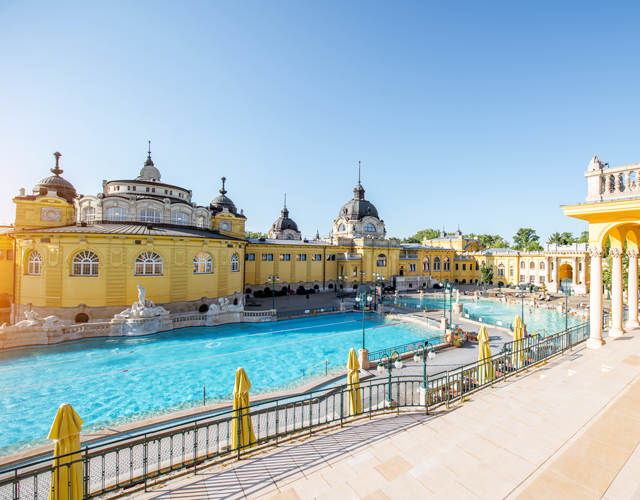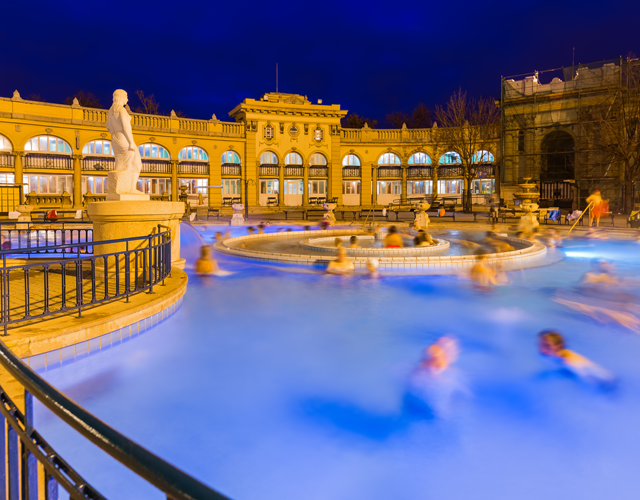So, if you’re ready to indulge in the healing powers of the thermal waters and discover the city’s hidden gems, let’s dive into the enchanting world of Budapest’s best baths. Get ready to unwind, rejuvenate, and experience the ultimate thermal paradise this city has to offer.
Table of Contents
Overview of Budapest’s Bath Culture
Budapest, the stunning capital of Hungary, is renowned for its rich bath culture that dates back centuries. With a history steeped in invasions and influences, Budapest is home to an impressive array of thermal baths and spas that have become an integral part of the city’s identity. From ancient Turkish baths to thermal bath complexes, Budapest offers a wide range of bathing experiences for locals and tourists alike. These are a brilliant way to take a break from the Budapest nightlife.
These baths are not only a place for relaxation and rejuvenation but also for socializing and indulging in the healing properties of the thermal waters. With unique architectural designs, stunning surroundings, and a variety of activities, Budapest’s bath culture is truly one of a kind.
Types of Baths in Budapest
Budapest is renowned for its variety of baths, each offering unique characteristics and features. Visitors can enjoy a range of bath experiences, including indoor and outdoor pools, thermal baths, and swimming pools. The city boasts both ancient and modern bath complexes, some dating back to the 12th and 16th centuries.
One of the most famous is the Széchenyi Baths, known for its thermal water and expansive outdoor pool. The Rudas Baths, with its Turkish bath and stunning architecture, provides a historical experience. The Gellért Baths offer hot springs of varying temperatures and healing properties.
Many of these baths have medicinal springs, and the water temperatures range from warm to hot. These thermal waters contain various minerals that are beneficial for health and relaxation. With a dozen thermal baths to choose from, visitors to Budapest can experience the therapeutic benefits of the city’s rich bath culture.
When you’re done with the baths, here are a few other places to check out:
Best restaurants Budapest has to offer
If you’re with a stag party, you can also ask your stag do company for advice. They can help you organize more to do after your bath session.
History of Budapest Baths
Budapest’s rich history adds an extra layer of charm to its renowned bath culture. Bathing tradition in the city can be traced back to ancient times, with the Romans being the first to take advantage of the area’s thermal springs.
However, it was during the Ottoman rule in the 16th century that the city truly embraced bath culture, with the construction of several Turkish baths still in use today. The 20th century saw a rise in the popularity of bath complexes, resulting in the creation of iconic locations like the Gellért and Széchenyi Baths. Today, Budapest’s bathhouses continue to attract locals and tourists alike, preserving the city’s centuries-old bathing traditions.
12th Century
In the 12th century, Budapest’s bath culture began to flourish, marking the beginning of a long-standing tradition. Ancient baths played a pivotal role in the city’s history, with their healing properties attracting locals and visitors alike. During this period, notable developments took place, shaping the bath experience as we know it today.
The baths were renowned for their varying water temperatures, providing therapeutic benefits for different ailments. These ancient baths became an essential part of daily life, offering relaxation, socializing, and rejuvenation to the people of Budapest. As centuries passed, the bath culture continued to evolve, giving rise to the stunning thermal bath complexes that can still be enjoyed in Budapest today.
16th Century
In the 16th century, Budapest’s bath culture began to flourish with the arrival of the Turks. The Turkish conquest brought with it the construction of opulent Hamman-style baths throughout the city. Among these baths were the renowned Rudas Baths, Király Baths, and Veli Bej Baths, which still stand today as testaments to Budapest’s rich bathing history.
These baths, with their intricate Turkish domes and warm waters, have survived the test of time and continue to be enjoyed by both locals and visitors. Stepping into these ancient spas is like stepping back in time, immersing oneself in the traditions and beauty of Budapest’s 16th-century bath culture.
20th Century
In the early 20th century, Budapest saw the construction of several iconic baths that have played a significant role in the development of the city’s bath culture. One such bath is the Széchenyi Baths, which opened in 1913 and is the largest medicinal bath in Europe. With its stunning Neo-Baroque architecture and numerous outdoor pools, Széchenyi Baths quickly became a beloved attraction for locals and tourists alike.
Another notable bath from this period is the Gellért Baths, which were completed in 1918. Situated in the beautiful Gellért Hill, these baths boast exquisite Art Nouveau decor and are renowned for their healing properties. The complex features a range of indoor and outdoor pools, as well as steam baths and cold plunge pools.
The construction of these iconic baths in the 20th century marked a pivotal moment in Budapest’s bath culture, further cementing the city’s reputation as a hub for thermal wellness. To this day, the Széchenyi Baths and Gellért Baths continue to draw visitors from around the world, offering a unique and rejuvenating bathing experience in the heart of Budapest.
The Top 5 Baths in Budapest
When it comes to baths in Budapest, there are several popular options that attract both locals and tourists alike. These baths not only offer a relaxing escape but also provide therapeutic benefits with their thermal waters and healing properties.
Széchenyi Baths
The Széchenyi Baths is not only one of the largest thermal bath complexes in Central Europe, but also the most famous in Budapest. With its vast array of pools, it is a popular choice among visitors seeking relaxation and rejuvenation.

The complex boasts 11 indoor thermal pools, three outdoor pools, and an outdoor swimming pool. Visitors can enjoy the healing properties of the thermal water while taking in the beautiful surroundings. In addition to the pools, the Széchenyi Baths offers a range of facilities, including the iconic sparties, which feature DJs and a bar on Saturday nights. Whether seeking therapeutic benefits or a unique experience, the Széchenyi Baths has something to offer everyone.

Gellért Baths
Located in Budapest, the Gellért Baths are a must-visit attraction for couples seeking relaxation in a stunning setting. Designed with stunning art nouveau architecture, these baths offer a unique experience. The thermal pools are filled with healing thermal water that ranges in temperature. Inside, visitors can enjoy a refreshing swim in the indoor swimming pool.
Outside, there is an exciting outdoor wave pool for added fun. Additionally, there are thermal sitting pools for those wanting to indulge in the healing properties of the thermal water. It’s important to note that the Gellért Baths close at 8pm and do not offer night openings. With its beautiful design and wide range of facilities, the Gellért Baths provide couples with a truly unforgettable experience.
Rudas Baths
The Rudas Baths in Budapest is a historic Turkish bath complex that has been in operation since the 16th century Ottoman empire. This makes it one of the city’s oldest and most iconic thermal bath complexes. The Rudas Baths boast a unique blend of traditional and modern features, offering visitors an authentic bathing experience.
One of the highlights is the octagonal plunge pool, which is surrounded by intricate marble columns and adorned with beautiful mosaics. The bath’s Turkish dome showcases stunning architectural design, creating a peaceful and atmospheric environment.
Additionally, a rooftop hot tub provides a relaxing space for guests to unwind while enjoying panoramic views of Budapest. The Rudas Baths is a must-visit destination for those seeking a truly immersive Turkish bath experience.
Király Baths
The Király Baths in Budapest are a historical gem, as they are the oldest thermal spa baths in the city. Built in the 16th century by the Ottoman Turks, these baths offer a glimpse into Budapest’s rich heritage. One of the main attractions is the Turkish octagonal thermal bath pool, which remains untouched since its construction.
Unlike some other bathhouses in the city, the Király Baths have not undergone extensive renovations, allowing visitors to experience the authentic ambiance of the past. With its fascinating history and unique architectural features, the Király Baths are a must-visit for those seeking a glimpse into Budapest’s past.
Lukács Baths
Located in Budapest’s Buda side, Lukács Baths is one of the popular baths in the city, with a rich historical background dating back to the 12th century. This thermal bath complex offers a wide range of facilities and pools for visitors to enjoy.
The outdoor swimming pool provides a refreshing experience, while the indoor pools offer a perfect retreat in any weather. Lukács Baths is well known for its medicinal springs, with thermal water renowned for its healing properties. Visitors can indulge in the warm waters and take advantage of the various water temperatures that cater to their preferences. With its unique blend of history and relaxation, Lukács Baths offers an authentic and rejuvenating experience for all visitors.
Types of Pools & Facilities Offered
Budapest is renowned for its wide variety of thermal baths and pools, each offering a unique experience for visitors. From outdoor pools to indoor pools, and from lap pools to plunge pools, there is something for everyone to enjoy.
Thermal Pools & Thermal Waters
One of the highlights of Budapest’s bath culture is the abundance of thermal pools and thermal waters that can be found throughout the city. These natural hot springs, combined with drilled wells, create a truly unique and rejuvenating experience for visitors. The thermal pools, filled with mineral-rich water, offer unparalleled relaxation and healing properties. The water’s heat and composition are believed to have various therapeutic effects on the body.
Turkish and Steam baths
Budapest is famous for its magnificent Turkish and steam baths, offering a unique bathing experience. The Széchenyi Baths, one of the city’s largest thermal bath complexes, hosts Saturday night “sparties” where visitors can enjoy music, light beams, and a vibrant atmosphere.
The Gellért Baths feature a stunning wine tub, allowing guests to soak in the healing properties of thermal waters infused with wine extracts.Lukács Baths boast a historic drinking hall, where visitors can sample the natural mineral-rich thermal waters.RudasBaths offer a rooftop hot tub with breathtaking views of the city, providing a truly relaxing experience.
These baths combine the soothing effects of steam and thermal waters to create an unforgettable bathing experience.
Conclusion: A Wellness Haven in Budapest
Budapest’s baths offer much more than mere relaxation; they provide a gateway to the city’s rich history, culture, and tradition of well-being. Each bath has its unique charm, and together, they form an unparalleled wellness haven that captivates the hearts of locals and tourists alike. Whether you seek a luxurious retreat or a glimpse into Budapest’s past, these baths promise an unforgettable experience.
So, what are you waiting for? Embark on an enriching journey of wellness and relaxation as you explore the 5 Best Baths in Budapest. Experience the magic of thermal waters, stunning architecture, and the warm embrace of Hungarian hospitality.
| Name | General Description | What Makes It Unique | What People Say | Opening times |
| Szechenyi Baths | Largest and most popular thermal bath in Budapest | Beautiful Neo-Baroque architecture | Relaxing atmosphere, variety of pools and facilities, affordable prices | 6:00 am to 10:00 pm, every day |
| Gellért Baths | Located in the Gellért Hill, one of the most iconic landmarks in Budapest | Beautiful Art Nouveau architecture, therapeutic waters | Calming ambiance, beautiful architecture, variety of pools and facilities | 6:00 am to 10:00 pm, every day |
| Rudas Baths | Thermal bath located in the Buda Castle District, one of the oldest thermal baths in Budapest | Unique Ottoman architecture, rooftop thermal pool with stunning views | Dignified vibe, classic building, affordable prices | 6:00 am to 10:00 pm, every day |
| Király Baths | Oldest thermal baths in Budapest, authentic Turkish atmosphere | Authentic Turkish atmosphere, affordable prices | Old world energy, authentic Turkish atmosphere, affordable prices | 6:00 am to 10:00 pm, every day |
| Lukács Baths | Thermal bath located in the Jewish Quarter of Budapest, known for its healing waters | Healing waters, variety of pools and facilities | Relaxing atmosphere, healing waters, variety of pools and facilities | 6:00 am to 10:00 pm, every day |




